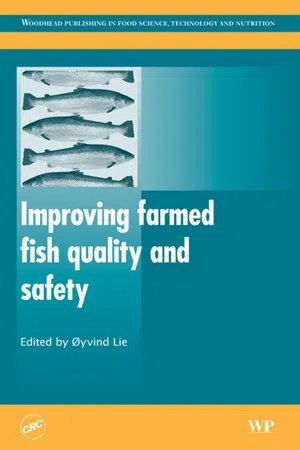
- 648 pages
- English
- ePUB (mobile friendly)
- Available on iOS & Android
Improving Farmed Fish Quality and Safety
About This Book
Global aquaculture production has grown rapidly over the last 50 years. It is generally accepted that there is limited potential to increase traditional fisheries since most fish stocks are well or fully exploited. Consequently increased aquaculture production is required in order to maintain global per capita fish consumption at the present level. Fish farming enables greater control of product quality and safety, and presents the possibility of tailoring products according to consumer demands. This important collection reviews safety and quality issues in farmed fish and presents methods to improve product characteristics.The first part of the book focuses on chemical contaminants, chemical use in aquaculture and farmed fish safety. After an opening chapter discussing the risks and benefits of consumption of farmed fish, subsequent contributions consider environmental contaminants, pesticides, drug use and antibiotic resistance in aquaculture. Part two addresses important quality issues, such as selective breeding to improve flesh quality, the effects of dietary factors including alternative lipids and proteins sources on eating quality, microbial safety of farmed products, parasites, flesh colouration and off-flavours. Welfare issues and the ethical quality of farmed products are also covered. The final part discusses ways of managing of product quality, with chapters on HACCP, monitoring and surveillance, authenticity and product labelling.With its distinguished editor and international team of contributors, Improving farmed fish quality and safety is a standard reference for aquaculture industry professionals and academics in the field.
- Reviews safety and quality issues in farmed fish and presents methods to improve product characteristics
- Discusses contaminants, persistent organic pollutants and veterinary drug residues and methods for their reduction and control
- Addresses important quality issues, genetic control of flesh characteristics and the effects of feed on product nutritional and sensory quality
Frequently asked questions
Information
The risks and benefits of consumption of farmed fish
Publisher Summary
1.1 Introduction: the human health implications of consumption of farmed fish
| Benefits | Risks |
| • Nutritional value (e.g., good quality protein) | • Microbiological problems (requires good hygiene and ice-cold storage) |
| • Essential n-3 fatty acids (cardiovascular and nervous system benefits, anticarcinogenicity) | • Toxins (e.g., botulinum toxin, certain algal toxins) |
| • Certain vitamins (e.g., vitamin D) and minerals (e.g., I, Se) | • Chemical contaminants (e.g., Hg, As, PCBs, dioxins, organochlorine pesticides) |
| • Replaces hard fats in diet |
1.2 Nutrients in fish and other seafood
1.2.1 Fat
Table of contents
- Cover image
- Title page
- Table of Contents
- Related titles
- Copyright
- Contributor contact details
- Preface
- Part I: Chemical contaminants, chemical use in aquaculture and farmed fish safety
- Part II: Improving farmed fish quality
- Part III: Managing farmed fish quality and safety
- Index